- Home
- Deborah Harkness
The World of All Souls Page 17
The World of All Souls Read online
Page 17
SIGNOR MISERONI
Full name: Ottavio Miseroni
Date of birth: 1567
Physical description: When Diana met him, he was a portly man in his twenties.
Family and romantic relationships: One of six generations of lapidary artists, from Francesco Miseroni in 1460 Milan to Ottavio’s grandson, Ferdinand Eusebio
Personal history: Rudolf II invited Ottavio Miseroni to Prague to set up a workshop with his brother in 1588, joining the community of artists and artisans drawn in by the emperor’s patronage. The talented Signor Miseroni was an Italian stonecutter from Milan and carved beautiful vases and fine images from crystal gemstones. He was appointed as official lapidary to the emperor’s court. In 1591 Ottavio was commissioned by Emperor Rudolf to carve Diana’s face into a gem in order to signify His Imperial Majesty’s steadfast and permanent affection for her.
Ottavio’s workshop flourished, and he developed his own distinctive style: many of his finest pieces can be seen in the Louvre. This continued, past his death in 1624, under his son and grandson, until Eusebio’s death in 1684.
See also: DECORATIVE ARTS: Herm in a Niche
N
ERNST NEUMANN
Origin of name: Neumann is of German origin, and the nickname for a newcomer to a place.
Date of birth: c. 1940
Family and romantic relationships: Ernst Neumann is Verin de Clermont’s human mate and, through her, part of the de Clermont clan.
Personal history: Ernst was a frightened six-year-old in Germany at the end of World War II when Verin rescued him from death at the hands of her mother, Ysabeau. Ysabeau had already killed his father. When he grew up, Ernst and Verin fell deeply in love and married when Ernst was twenty-five. His vampire wife stayed forever young, and now, as an older man, living in Berlin, he is the envy of all his friends. Ernst has a healthy distrust of the shadier de Clermonts, including Baldwin, who trained him in the intricacies of international commerce when Ernst was a young man. But he married Verin knowing what she was and accepts the complicated and tangled tales of blood and desire surrounding her family.
JOHN NORMAN AND JEFFREY NORMAN
John and Jeffrey were sons of Susanna Norman in sixteenth-century London and their names are recorded in the registers of St. James Garlickhythe alongside their mother.
SOPHIE NORMAN
Other name: Sophie Wilson
Origin of name: From the Greek sophia, meaning “wisdom”
Date of birth: February 26, 1984
Astrological sign: Pisces
Physical description: Sophie has a sweet, round face and brown eyes. She wears her long hair in a braid and speaks with a soft southern accent.
A member of: The Conventicle
Family and romantic relationships: Married to daemon Nathaniel Wilson; together they have a daughter, Margaret Wilson, who is a witch. She is godmother to Philip Bishop-Clairmont.
Personal history: Sophie Norman grew up in modern-day North Carolina, in the lushly beautiful but sparsely populated town of Seven Devils, surrounded by the Blue Ridge Mountains and the southern Appalachians. She is a daemon born into a family of witches—her parents and grandparents were witches, her grandmother’s house had ghosts who were witches, and Sophie’s mother was also a timewalker.
As a student at the University of North Carolina, Chapel Hill, Sophie met and fell in love with another daemon, Nathaniel Wilson. They married, and when she became pregnant, Sophie soon realized that the baby would be a witch. They knew enough of creature reproduction to know that their family was unusual at best and feared that the Congregation might harm them or their baby.
Mild-mannered and a bit dreamy, like many daemons, Sophie is also a determined, intrepid young woman. She has powerful visions of the future, and she’s a gifted artist, a potter like her mother and grandmother, though unlike them she doesn’t use witchfire—just ordinary fire—in her kilns. But Sophie’s pots are extraordinary daemonic creations, because she forms the faces from her dreams and visions into jugs. In fact, it was a recurrent dream about the witch Diana Bishop and premonitions of approaching danger that drew an expectant Sophie and her husband, Nathaniel, to the Bishop house in Madison, New York.
For centuries Sophie’s maternal family, the Normans, safeguarded a small silver statue of the goddess Diana that they passed down through generations of witches, until “the time comes [to] give it to the one who has need of it.” The statue is a chess piece from a set given to Matthew de Clermont by Philippe, a piece that Matthew lost in a wager to Christopher Marlowe on All Souls’ Night in 1590. The chess piece that Sophie delivered to Diana and Matthew was key to guiding them to the relative safety of sixteenth-century England.
Sophie has an unusual and circuitous manner of speaking, but the effect is disarming and soothing rather than unsettling. Her occasional flashes of brilliance, such as her observation that the group of vampires, witches, and daemons gathered at the Bishop house were sufficient to form a conventicle, can be startling coming from a young woman who frankly seems more interested in baking cookies than making war.
SUSANNA NORMAN
Origin of name: Susanna is from Hebrew and Greek origins, meaning “lily.”
Date of birth: c. 1560s
Physical description: When Diana encountered Susanna she had a round-face with a snub nose, a gentle chin, and rich brown hair and eyes—just like her descendant Sophie Norman.
A member of: The St. James Garlickhythe gathering/coven
Family and romantic relationships: Mother of John and Jeffrey Norman, aunt of Annie Undercroft, ancestor of Sophie Norman
Personal history: Susanna Norman was a midwife and witch in sixteenth-century London. She introduced Diana to Goody Alsop after seeing Diana’s unusual magical powers. Susannah Norman is mentioned in the sixteenth-century parish register of St. James Garlickhythe, where she is described as midwife to Hugh Plat.
O
HAMISH OSBORNE
Origin of name: Hamish is of Scottish origin, the anglicized version of the Gaelic Seumas.
Date of birth: August 19, 1972
Astrological sign: Leo
Physical description: Hamish is a dapper, handsome man in his thirties. He is dark and about five-eleven.
A member of: The Knights of Lazarus, the Conventicle, All Souls College, Oxford University
Family and romantic relationships: Hamish is from a Glaswegian family. He is unmarried and still looking for the perfect partner. He is godfather to Philip Bishop-Clairmont.
Personal history: Hamish Osborne is a genius. Everybody knows that. What most people don’t know is that he is a daemon and gay. The former rules out his seemingly inevitable appointment as chancellor of the exchequer, although Labour leaders continually press him to run for his Glasgow constituency.
Hamish is Matthew Clairmont’s closest friend. The two met at All Souls, where both had received prestigious Prize Fellowships. Their friendship is based on respect and intellectual compatibility. Few creatures can keep up with them when they start arguing and tossing around literary references and philosophical ideas. Hamish has a healthy sense of Matthew’s strengths (like loyalty) and his weaknesses (like secrecy), but Hamish’s friendship is freely given and unconditional. Along with Miriam, Hamish is one of the few creatures who speaks the truth to Matthew.
He is a member of the Conventicle, which formed at the Bishop house in upstate New York, in defiance of the Congregation and its covenant, and Hamish oversaw the legal arrangements that Diana and Matthew made before they timewalked to sixteenth-century London. Matthew, controversially, appointed him as the ninth knight in the Knights of Lazarus. Marcus promoted him to a higher position when he took control of the order.
Hamish owns a glorious hunting lodge in Lanarkshire, where Matthew often goes to get away from the press of warmbloods in Oxford and to h
unt in the open air as a vampire should. Hamish looks forward to those times in Scotland as they often show sides of Matthew that few are allowed to see. There the two hunt, play chess, drink too much, and talk long into the night.
Hamish is forever in search of his perfect partner—and hasn’t found him yet. He had been involved with a vain but beautiful human named William, who sometimes resented how much time Hamish spent with Matthew and doesn’t know that Hamish is a daemon.
Hamish comes from a working-class background in Glasgow. His father was an insurance salesman and his mother a full-time homemaker. Hamish was their only child and somewhat perplexing to the very ordinary humans who produced him. His life was changed forever when a mathematics prodigy at the university recognized him as a daemon and explained to the Osbornes how the world really worked and what kinds of creatures were in it. Were it not for that intervention, Hamish wouldn’t have turned out so well.
He shops on Jermyn Street and Savile Row, likes Liberty of London ties, buys wine at Berry Brothers & Rudd, has a penthouse in Canary Wharf, and frequents the clubs of Soho. He is one of the regular power breakfasters at the Wolseley, where they always give him the best table no matter how crowded the restaurant is.
P
SIGNOR PASETTI
Full name: Alfonso Pasetti
Date of birth: c. 1560s
Personal history: Born in Ferrara, Italy, Signor Alfonso Pasetti was Emperor Rudolf II’s dancing master, charged with overseeing the dancing for the grand court entertainments. Pasetti conducted dance performances at spectacular balls, and he also choreographed dance numbers for masques such as those at the spring festival in Prague where Diana and Matthew performed scenes from the myth of Diana and Endymion.
See also: LIFESTYLE: Dancing
HENRY PERCY
Other name: Earl of Northumberland
Origin of name: Henry is an English name, derived from Old German variations of Haimirich, meaning “home ruler.”
Date of birth: April 27, 1564
Astrological sign: Taurus
Physical description: A lanky young man with a broad face, heavy ash-colored eyebrows, and a pronounced widow’s peak
A member of: The School of Night, the Knights of Lazarus
Family and romantic relationships: Married to Dorothy Devereux, sister of Robert Devereux, Earl of Essex
Personal history: Henry Percy, the ninth Earl of Northumberland, was a wellborn and extremely wealthy nobleman in Elizabethan England. His nickname, the “Wizard Earl,” came from his scientific achievements and his interest in alchemy, mathematics, and cartography, as well as a reference to his famously large library. He was slightly hard of hearing and plagued by a stammer, but neither condition hindered his intellectual curiosity or affected his status as a member of the aristocracy. Henry Percy possessed a wide circle of influential friends, including Mary Sidney, Countess of Pembroke. She shared his scientific interests, and it was Henry Percy who thought to introduce Diana Bishop to the countess.
Percy kept slightly less orthodox company as well. He corresponded frequently with John Dee, the queen’s astrologer, and belonged to that group of suspiciously freethinking intellectuals known as the School of Night, which included Sir Walter Raleigh, Thomas Harriot, George Chapman, Kit Marlowe, and of course Matthew Roydon. Besides providing the stimulation of their company, Raleigh and Harriot also introduced Percy to the gladdening pleasures of tobacco smoking, a habit they’d brought back from the British colony of Virginia.
Percy professed to be Protestant, but he was widely and correctly suspected to be Catholic. His Catholicism made him vulnerable in Protestant England, so Philippe de Clermont offered Henry a position as the ninth knight of the Knights of Lazarus to help protect him. Unfortunately, his position with the Knights of Lazarus did little to shield him from the more common irritations in his life, particularly his fractious and demanding mother, with whom he had a difficult relationship.
Percy’s Catholic leanings did eventually catch up with him. Soon after Queen Elizabeth’s death, King James had him confined to the Tower of London for involvement in the Gunpowder Plot, a failed attempt by a group of English Catholics to overthrow the king. Even though Henry Percy seemed not to have known of the plot, he spent seventeen years locked in the tower. Percy made the best of an unpleasant situation, receiving visitors from the outside such as Thomas Harriot, as well as keeping company with other unfortunates who’d been locked up, including Walter Raleigh. Henry also had a bowling alley built in the tower and would smoke tobacco with friends. He was released in 1621 and lived for another decade.
JOHANNES PISTORIUS
Full name and other names: John Pistorius, Johann Pistorius the Younger, Niddanus
Date of birth: February 14, 1546
Astrological sign: Aquarius
Physical description: Fleshy, with heavy-lidded eyes
Family and romantic relationships: Son of a Protestant minister, Johann Pistorius the Elder, from Germany
Personal history: Johannes Pistorius was a theologian and physician who grew up Lutheran, converted to Calvinism, then became a Catholic priest. He became an imperial councillor and later confessor to Rudolf II.
Diana found out that Pistorius was another university-educated wizard and being groomed for membership in the Congregation. She and Matthew met him at the court of Rudolf II in Prague, where his probing gaze unsettled Diana.
WILLIAM PONSONBY
Origin of name: Ponsonby is an old English place-name, from those of the parish of Ponsonby in the north of England.
Date of birth: c. 1546
A member of: The Stationers’ Company
Personal history: One of the most prominent publishers of the Elizabethan era, William Ponsonby set up shop at the Bishop’s Head, in St. Paul’s Churchyard in sixteenth-century London. He published his first works in 1579, a conduct manual for women and a Protestant sermon. He went on to seek out works of poetry and fiction that he judged would appeal to highbrow literary sensibilities and yet be commercially successful. When Ponsonby managed to secure the Countess of Pembroke’s blessing to publish Arcadia, which was written by her late brother, Sir Philip Sidney, its critical and financial success secured Ponsonby’s standing as a publisher. He later published work by George Chapman, including The Shadow of Night, and Mary Sidney, as well as Edmund Spenser, author of The Faerie Queene.
Ponsonby avoided publishing more lowbrow fiction, including the plays that were so popular in London at the time. He refused outright to publish Christopher Marlowe’s early work, and the resentful Kit never forgave him. Likewise, Ponsonby never published any of William Shakespeare’s plays, though one of his former apprentices, Edward Blount, went on to publish the First Folio of Shakespeare’s plays in 1623, many decades after Ponsonby’s death.
As George Chapman confided to Diana, William Ponsonby would have liked to publish Matthew Roydon’s poetry, but Matthew refused, making the excuse that he wrote poems only for his friends.
MASTER PRIOR
Master Prior was a maker of meat pies in sixteenth-century London and served as Matthew and Diana’s source for “takeout” during their stay.
STEPHEN PROCTOR
Full name: Stephen Addison Proctor
Origin of name: Stephen is of Greek origin, meaning “crown,” or literally “that which surrounds.”
Date of birth: October 5, 1939
Astrological sign: Libra
Physical description: Stephen was handsome in a tweedy, intellectual sort of way. He was of average height and build, not terribly athletic, and his fingers were perpetually stained with ink.
Family and romantic relationships: The Proctors are a distinguished witch family, and several members were accused during the Salem Witch Trials. Stephen was husband to witch Rebecca Bishop and father of Diana Bishop.
Personal history:
Like his wife, Rebecca Bishop, Stephen Proctor was descended from victims of the Salem Witch Trials. Five members of the Proctor family were accused of witchcraft during the panic, though only John Proctor was executed. But the Proctor family has never excelled at the craft, and Stephen was no exception. He had lackluster spell-casting abilities, little apparent elemental magical talent, and zero ambition to participate in witch society.
In reality Stephen did have magical abilities—like his daughter, he just didn’t understand them and had learned to hide them from other witches. He could timewalk, for example, and travel to past worlds—a useful skill for an anthropologist. Stephen had a familiar, a heron, that only he could see. And though he was keenly intelligent and had a sharp memory, Stephen couldn’t perform any but the most basic spells unless he wrote them himself. Though Stephen didn’t know it, he was a weaver. And his daughter, Diana, seems to have inherited his few, erratic magical talents.
He didn’t care about being a great witch and was content to have his wife occupy the limelight. Though Stephen was a solid scholar, his work lacked Rebecca’s brilliance. He was content to let Rebecca outshine him there, too. After he met Rebecca, Stephen’s priority was to keep his wife safe, happy, and smiling. This was his whole world, at least until Diana came along. Stephen was a wonderful husband, a devoted father, and a genial member of his academic and neighborhood communities.

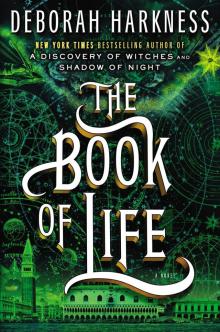 The Book of Life
The Book of Life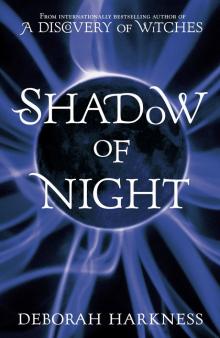 Shadow of Night
Shadow of Night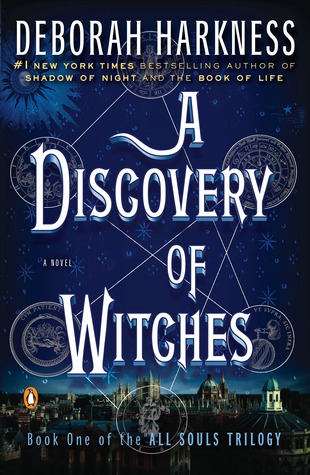 A Discovery of Witches
A Discovery of Witches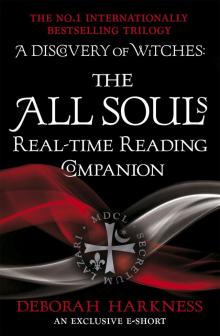 The All Souls Real-Time Reading Companion
The All Souls Real-Time Reading Companion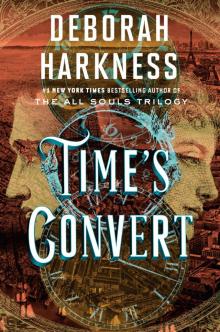 Time's Convert
Time's Convert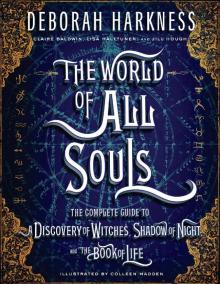 The World of All Souls
The World of All Souls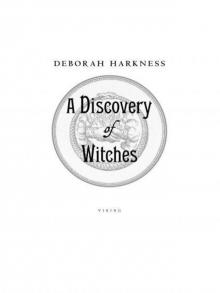 A Discovery of Witches: A Novel (All Souls Trilogy)
A Discovery of Witches: A Novel (All Souls Trilogy) Shadow of Night: A Novel
Shadow of Night: A Novel